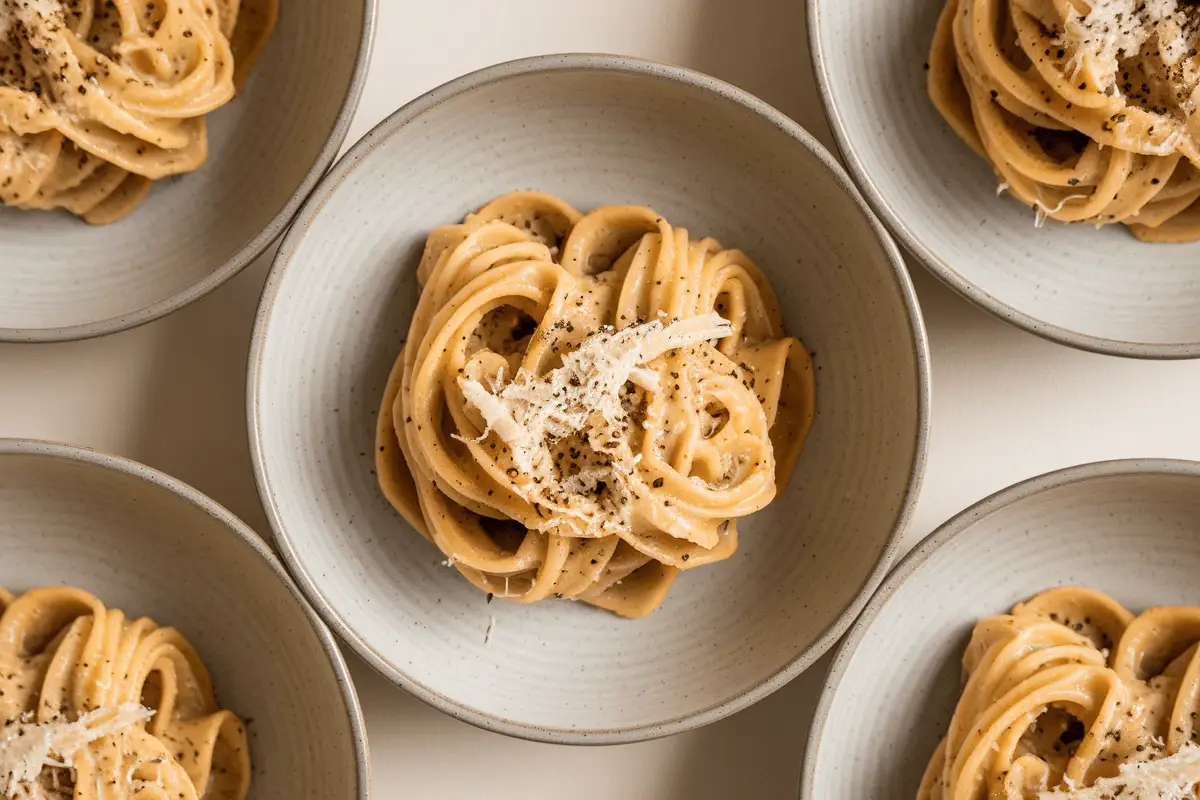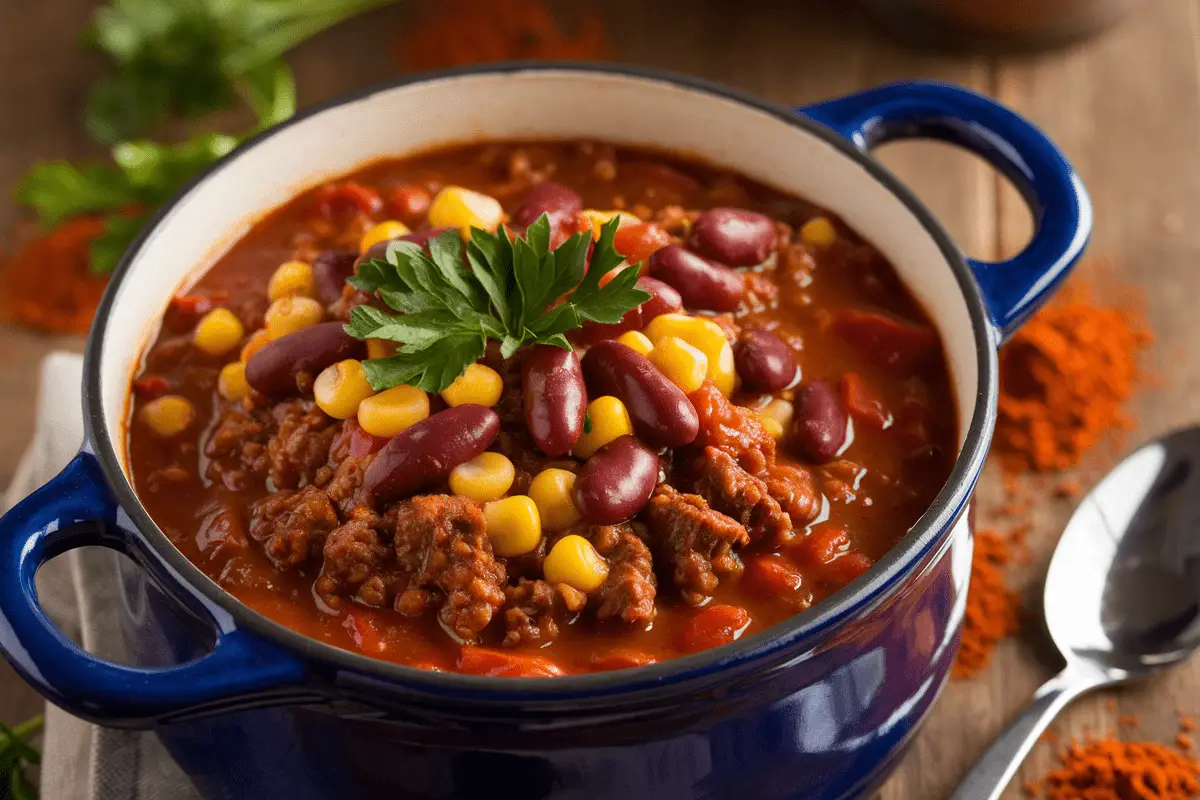Indulge in the simplicity of Italian cuisine with Cacio e Pepe, a dish that epitomizes the beauty of minimalism. Originating in Rome, this pasta recipe, meaning “cheese and pepper,” requires just a handful of ingredients but delivers bold, comforting flavors. Whether you’re looking for a quick dinner or a taste of tradition, this recipe promises to satisfy.
- Key highlights:
- Only three main ingredients: Pecorino Romano cheese, black pepper, and pasta.
- Perfect for both casual meals and elegant dinners.
- A dish rich in history yet easy to master.
With the right techniques, you can achieve a creamy, flavorful sauce that clings perfectly to the pasta. Interested in more pasta inspiration? You might enjoy the variations showcased in this guide to Easy Pasta and Peas Recipe, which complements the rustic simplicity of Italian cooking.
This recipe will teach you how to achieve perfection every time.
What is Cacio e Pepe?

Cacio e Pepe is a quintessential dish of Roman cuisine that highlights the beauty of simplicity. Translating to “cheese and pepper,” this recipe relies on a minimalist combination of just a few ingredients to deliver bold, comforting flavors.
- Historical Significance:
Rooted in Roman shepherd traditions, the dish originated as an easy-to-make meal for herders who carried dry pasta, Pecorino Romano cheese, and black pepper during their travels. - Cultural Appeal:
Loved for its creamy, peppery sauce that coats each strand of pasta, Cacio e Pepe has become a staple in Italian households and fine dining alike. - Why It Stands Out:
- Emphasizes high-quality ingredients to let simple flavors shine.
- Requires no exotic spices or fancy tools.
- A true representation of Italian culinary philosophy: less is more.
For another comforting recipe steeped in history, explore this delightful Noodle Pudding Recipe that similarly celebrates the richness of tradition through simple ingredients.
Whether you’re a fan of authentic Italian dishes or love discovering recipes with cultural roots, Cacio e Pepe promises an unforgettable culinary experience.
Ingredients Breakdown

Creating the perfect Cacio e Pepe begins with selecting the finest ingredients. This dish relies on simplicity, so each component plays a crucial role in achieving its signature creamy texture and bold flavor.
Primary Ingredients
- Pasta: Traditional recipes use spaghetti or tonnarelli, known for their ability to hold the sauce. Opt for high-quality, durum wheat pasta for the best results.
- Pecorino Romano Cheese: Aged and salty, Pecorino Romano adds a sharp, tangy flavor to the dish. Grating it finely ensures it melts smoothly into the sauce.
- Black Pepper: Freshly cracked black peppercorns are essential. Their pungent aroma and spicy kick are at the heart of Cacio e Pepe.
- Pasta Water: The starchy water acts as an emulsifier, binding the cheese and pepper into a silky sauce.
Optional Additions
- Olive Oil or Butter: While traditionalists may object, some modern versions incorporate these to enhance the sauce’s creaminess.
- Parmesan Cheese: Occasionally, Parmesan is mixed with Pecorino for a milder flavor.
Pro Tips for Ingredient Quality
- Choose authentic Pecorino Romano imported from Italy for the best taste.
- Avoid pre-grated cheese, which may contain additives that hinder melting.
- Toast the black pepper in a dry pan before adding it to the dish to unlock its full aroma.
For more ideas on incorporating simple yet flavorful ingredients, check out this recipe for a comforting Chicken and Peppers Recipe, where fresh produce takes center stage.
With these essentials, you’ll be on your way to mastering this timeless Roman classic.
The Science Behind Cacio e Pepe
The magic of Cacio e Pepe lies in its deceptively simple process, which transforms just a few ingredients into a luxurious, creamy sauce. Understanding the science behind the dish ensures success every time you make it.
Emulsification: The Key to Creaminess
- The sauce relies on emulsification, a process where water and fat bind together to form a smooth, stable mixture.
- The starchy pasta water is the star here, helping the finely grated Pecorino Romano cheese melt without clumping.
- Properly combining the cheese, water, and pasta at just the right temperature is essential to achieving that velvety texture.
Balancing Heat and Ingredients
- Heat plays a critical role. If the cheese is exposed to too much heat, it can seize up and form clumps instead of blending into the sauce.
- To avoid this, mix the cheese and starchy water off the heat, ensuring a controlled environment for the emulsion to form.
Texture is Everything
- The sauce should cling to the pasta evenly, creating a cohesive dish where every bite is packed with cheesy, peppery flavor.
Looking for more insights into achieving culinary perfection? Explore this Simple Moussaka Recipe for another dish that relies on precise layering and texture.
With these scientific principles in mind, you’ll turn your Cacio e Pepe into a restaurant-worthy masterpiece every time.
Step-by-Step Recipe
Creating the perfect Cacio e Pepe requires attention to detail and simple yet precise techniques. Follow these steps to achieve a creamy, flavorful dish that rivals any Italian restaurant.
1. Preparation
- Begin by grating Pecorino Romano cheese as finely as possible. The finer the cheese, the easier it will melt into a smooth sauce.
- Use a pepper grinder to crack fresh black peppercorns. Toasting the pepper in a dry skillet enhances its aroma and flavor.
- Bring a large pot of salted water to a boil. Use less salt than usual since Pecorino Romano is naturally salty.
For another flavorful dish that highlights preparation techniques, try this Tex-Mex Cuisine Recipe for inspiration.
2. Cooking the Pasta
- Add your choice of spaghetti or tonnarelli to the boiling water. Cook until just al dente, as the pasta will continue cooking slightly when mixed with the sauce.
- Reserve at least one cup of starchy pasta water before draining. This is critical for emulsifying the sauce.
3. Toasting the Pepper
- In a large skillet, toast the cracked black pepper over medium heat until fragrant. This releases the essential oils, deepening the pepper’s flavor.
- Add a ladle of the reserved pasta water to the skillet, creating a flavorful pepper broth.
4. Creating the Sauce
- Reduce the heat and gradually whisk the finely grated Pecorino Romano into the hot pasta water. Do this off the heat to prevent the cheese from clumping.
- Stir vigorously to create an emulsion that is creamy and smooth.
5. Combining Everything
- Add the cooked pasta to the skillet with the pepper broth. Toss to coat the pasta evenly.
- Gradually pour in the cheese mixture, tossing continuously to ensure every strand of pasta is covered in the sauce.
- Adjust the consistency by adding small amounts of reserved pasta water as needed.
6. Final Touches
- Plate the pasta and garnish with extra freshly grated Pecorino Romano and a sprinkle of toasted black pepper.
- Serve immediately for the best taste and texture.
Looking for a side dish to complement your Cacio e Pepe? Consider this vibrant Quinoa Tabbouleh Salad for a refreshing contrast.
Tips for Success
- Always mix the cheese and pasta water off the heat to prevent clumping.
- Use fresh, high-quality ingredients for the best flavor.
- Don’t rush the emulsification process—it’s the key to a creamy sauce.
With these steps, you’ll master the art of Cacio e Pepe and impress your guests with a dish that embodies the essence of Italian simplicity.
Common Mistakes to Avoid
While Cacio e Pepe is a deceptively simple dish, a few common errors can prevent you from achieving its signature creamy, peppery perfection. Avoid these pitfalls to ensure success every time.
1. Overheating the Cheese
- Pecorino Romano cheese is sensitive to high heat. If added to a hot pan or boiling water, it will clump instead of melting smoothly. Always mix the cheese with the starchy pasta water off the heat to create an emulsion.
2. Using Pre-Grated Cheese
- Store-bought pre-grated cheese often contains anti-caking agents that hinder its ability to melt properly. Grate fresh Pecorino Romano for the best results.
3. Skipping the Starchy Water
- The reserved pasta water is essential for creating a creamy sauce. Without it, the dish will lack the emulsified texture that defines Cacio e Pepe. Always save at least a cup of pasta water before draining.
For another recipe that relies on emulsification techniques, try this Hot Honey Pepperoni Pizza Recipe, where flavors and textures balance beautifully.
4. Over-Salting the Pasta Water
- Pecorino Romano is naturally salty, so adding too much salt to the pasta water can result in an overly salty dish. Use just enough salt to enhance the pasta’s flavor without overpowering it.
5. Rushing the Process
- Achieving the perfect Cacio e Pepe requires patience. Take your time to toast the pepper, emulsify the sauce, and coat the pasta thoroughly.
By avoiding these common mistakes, you’ll consistently achieve the creamy, peppery perfection that makes Cacio e Pepe a timeless favorite.
Variations of Cacio e Pepe
Cacio e Pepe is a versatile dish that lends itself to a variety of creative twists while still retaining its classic charm. Whether you want to modernize the recipe or adapt it to dietary needs, here are some exciting variations:
1. Truffle Cacio e Pepe
- Add a drizzle of truffle oil or shaved truffles for a luxurious upgrade. The earthy aroma pairs beautifully with the peppery and cheesy sauce.
2. Mixed Cheese Blend
- While traditionalists stick to Pecorino Romano, some variations incorporate Parmesan or Asiago for a milder, nuttier flavor profile. This blend also softens the sharpness of Pecorino.
3. Vegan Cacio e Pepe
- Replace Pecorino Romano with a mixture of nutritional yeast and cashew cream for a creamy, plant-based alternative. Toss with gluten-free pasta for a fully vegan and gluten-free option.
4. Protein-Enhanced Variations
- Add grilled shrimp, crispy pancetta, or sautéed chicken for a heartier meal. These additions blend seamlessly with the rich, peppery sauce.
For a creative recipe with added protein and unique flavors, consider this Crab Eggs Benedict Recipe for inspiration.
5. Seasonal Additions
- Incorporate fresh, seasonal ingredients like asparagus, peas, or zucchini for a lighter, spring-inspired version of Cacio e Pepe.
These variations show how Cacio e Pepe can be reimagined to suit different tastes and occasions while staying true to its roots as a simple, flavorful dish.
Serving Suggestions
The simplicity of Cacio e Pepe makes it an ideal dish to pair with a variety of sides and accompaniments. Elevate your dining experience with these serving ideas:
1. Side Dishes
- Serve alongside a simple green salad with a lemon vinaigrette to provide a refreshing contrast to the creamy pasta.
- Roasted vegetables like asparagus or brussels sprouts are excellent complements to Cacio e Pepe’s bold flavors.
Looking for a unique vegetable side? This Smoked Paprika Kale Chips Recipe offers a smoky crunch that pairs beautifully with creamy pasta.
2. Occasions to Serve
- Perfect as a weeknight comfort food when you’re short on time but craving something indulgent.
- Also elegant enough for a dinner party or date night, offering sophistication with minimal effort.
With these serving ideas, you can transform Cacio e Pepe into a complete meal that’s satisfying and memorable.
Storage and Reheating Tips
Proper storage and reheating are key to preserving the creamy, cheesy goodness of Cacio e Pepe. Follow these tips to enjoy your leftovers without compromising texture or flavor.
1. Storage Tips
- Refrigeration: Store leftover Cacio e Pepe in an airtight container. It will keep for up to 3 days in the refrigerator.
- Avoid drying out: Add a small drizzle of olive oil before storing to prevent the pasta from sticking together.
2. Reheating Tips
- Stovetop Method: The best way to reheat Cacio e Pepe is in a skillet. Add a splash of water or milk to loosen the sauce and stir gently over low heat until warmed through.
- Microwave Option: If using a microwave, cover the pasta with a damp paper towel and heat in short intervals, stirring in between.
For reheating inspiration, try techniques used in this creamy Chicken Bone Broth Recipe, which focuses on retaining moisture and flavor.
With these tips, your leftover Cacio e Pepe will taste almost as good as the freshly prepared dish. Avoid freezing, as the texture of the cheese sauce may not hold up well.
FAQs Section
Here are answers to some frequently asked questions about Cacio e Pepe to help you perfect this classic recipe.
1. What kind of cheese can I use if I don’t have Pecorino Romano?
- If you can’t find Pecorino Romano, substitute it with Parmesan cheese for a milder flavor. For a more authentic taste, mix it with a small amount of grated Asiago.
2. Can I make Cacio e Pepe gluten-free?
- Absolutely! Use gluten-free pasta and ensure your cheese is free from additives. Brands that focus on natural, high-quality ingredients work best for achieving the creamy texture you want.
For a gluten-free dish packed with flavor, check out this Canned Tomato Soup Recipe for inspiration.
3. Why does my cheese clump?
- Clumping happens if the cheese is added to a pan that is too hot or if it is not grated finely enough. Always mix the cheese with the starchy pasta water off the heat to create a smooth emulsion.
4. How do I achieve a smooth sauce?
- Use freshly grated cheese, and ensure the pasta water is hot but not boiling. Stir vigorously to combine the water, cheese, and pasta into a creamy sauce.
5. Can I prepare Cacio e Pepe ahead of time?
- It’s best enjoyed fresh, but you can prep the grated cheese and cracked pepper in advance. Cook the pasta and assemble the sauce just before serving.
These FAQs address common concerns to ensure your Cacio e Pepe turns out perfect every time. With the right techniques and ingredients, it’s easy to master this classic dish!
Conclusion

Cacio e Pepe is a timeless testament to the beauty of Italian simplicity. With just a handful of ingredients—Pecorino Romano, black pepper, and pasta—you can create a dish that is creamy, flavorful, and deeply satisfying. Its minimal preparation makes it perfect for both casual weeknight meals and elegant gatherings.
- By mastering techniques like emulsification and using high-quality ingredients, you can recreate this Roman classic with ease.
- Avoid common mistakes, such as overheating the cheese or skipping the starchy pasta water, to ensure your dish achieves its iconic texture.
Pair Cacio e Pepe with a crisp salad, a glass of wine, or even a comforting soup. For a light yet hearty option, try this Marry Me Pasta Recipe as another creamy, indulgent dish to explore.
With its versatility and rich history, Cacio e Pepe is a dish every home cook should master. Ready to start? Buon appetito!
External Links and Recommended Anchor Text
· Master the Classic Spaghetti Cacio e Pepe Recipe
- Anchor Text: “Master the classic Spaghetti Cacio e Pepe recipe with this step-by-step guide.”
· Bon Appétit’s Ultimate Cacio e Pepe Recipe
- Anchor Text: “Try Bon Appétit’s ultimate Cacio e Pepe recipe for an authentic taste of Rome.”
· Geoffrey Zakarian’s Cacio e Pepe on Food Network
- Anchor Text: “Explore Geoffrey Zakarian’s expert take on Cacio e Pepe from Food Network.”


